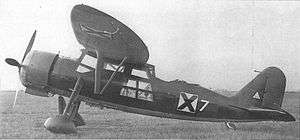Kaproni Bulgarski KB-11 Fazan
The Kaproni Bulgarski KB-11 Fazan (English: Pheasant) was a 1940s Bulgarian army liaison and utility monoplane built by Kaproni Bulgarski, a subsidiary of the Italian aviation conglomerate Società Italiana Caproni.
| KB-11 Fazan | |
|---|---|
 | |
| Role | Army liaison monoplane |
| National origin | Bulgaria |
| Manufacturer | Kaproni Bulgarski |
| Designer | Carlo Caligaris |
| First flight | 1941 |
| Introduction | 1942 |
| Retired | 1958 (Yugoslavia) |
| Primary user | Bulgarian Air Force
Yugoslav Air Force (postwar) |
Development and design
The prototype Fazan flew in 1941 as a shoulder-wing monoplane powered by a 750 hp (559 kW) Alfa Romeo 126 R.C.34 radial engine.[1] It had a fixed conventional landing gear with a tailwheel. Flight testing of the prototype showed that the aircraft was unstable and was nose-heavy in level flight, and was considered unsafe during forced-landings. By analogy with the Hunchback of Notre-Dame, the prototype gaining the unflattering nickname "Quasimodo".[2]
The second prototype was redesigned with a high-wing, a revised undercarriage and new cockpit glazing, while retaining the engine and three-bladed fixed-pitch propeller of the first prototype. The revised aircraft successfully passed its flight trials, and a small batch of six similar aircraft, designated KB-11-I, followed.[2] While this batch was being built, a further-revised version was produced, the KB-11-II. This took advantage of the availability of large quantities of PZL-license built Bristol Pegasus engines that had been captured by the Germans during the Invasion of Poland, with a Pegasus XXI driving a two-bladed wooden propeller replacing the Alfa-Romeo, while the fuselage glazing was changed again. This revised aircraft was renamed Fazan, and was followed by 43 production aircraft.[2]
Operational history
The KB-11 was used to replace Letov Š-328s and PZL P.43 in the short-range reconnaissance squadrons of the Bulgarian Air Force, equipping four squadrons. Fazans were used in joint Bulgarian-German-Italian operations against Tito's Partisans in Serbia from 1943.[2][3] Following Bulgaria's armistice with the Soviet Union and declaration of war against Germany in September 1944, the Bulgarian Air Force was used in support of Bulgarian Army forces in Serbia and Macedonia who were fighting against their former allies. KB-11 equipped units saw only limited use in this offensive, possibly because of the aircraft's similarity to the German Henschel Hs 126.[4][5]
In 1947, 30 KB-11s were transferred to Yugoslavia as part of war reparations following the Paris Peace Treaties. They were used as trainers, liaison aircraft and target tugs. The wooden wings were replaced by metal wings by Ikarus, allowing the KB-11 to continue in service in Yugoslavia until 1958.[6]
Specifications
General characteristics
- Crew: 2 (pilot, observer/gunner)
- Length: 10.06 m (33 ft 0 in)
- Wingspan: 13.3 m (43 ft 8 in)
- Height: 4.2 m (13 ft 9 in)
- Wing area: 25.2 m2 (271 sq ft)
- Empty weight: 2,310 kg (5,093 lb)
- Max takeoff weight: 3,160 kg (6,967 lb)
- Powerplant: 1 × PZL Pegasus XXI radial, 835 kW (1,120 hp)
- Propellers: 2-bladed
Performance
- Maximum speed: 275 km/h (171 mph, 148 kn)
- Range: 620 km (390 mi, 330 nmi)
- Service ceiling: 6,096 m (20,000 ft)
Armament
- Guns: 2 × 7.92mm Zbrojovka M-30 machine guns in nose and two at observer's station
- Hardpoints: 6
- Bombs: 2 × 100kg bombs, 4x50kg bombs, or 6x25kg bombs
References
Notes
- Orbis 1985, p. 2234
- Bernád 2001, p. 16.
- Green and Swanborough 1989, p. 70.
- Green and Swanborough 1989, pp. 73–74.
- Bernád 2001, pp. 16–17.
- Bernád 2001, p. 17.
Bibliography
- Bernád, Dénes. "Balkan Birds: Thirty-Five Years of Bulgarian Aircraft Production: Part Two". Air Enthusiast. No. November/December 2001, No. 96. pp. 10–17. ISSN 0143-5450.
- Green, William; Swanborough, Gordon. "Balkan Interlude: The Bulgarian Air Arm in WWII". Air Enthusiast. No. Thirty–nine, May–August 1989. pp. 58–74. ISSN 0143-5450.
- The Illustrated Encyclopedia of Aircraft (Part Work 1982-1985). Orbis Publishing.